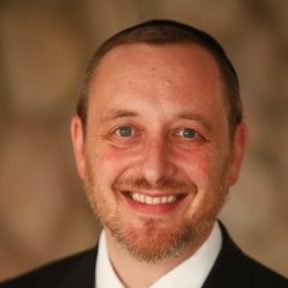Mountains of Hatred

No matter how much we try to fit in, the world will remind us that we don’t

“Why is [the mountain where the Torah was given] called Har Sinai? Because it’s the mountain where sinah descended upon the Nations of the World.” (Shabbos 89a)
Har Sinai is the world’s most important mountain, host to history’s most important event. We would expect the name of the mountain to reflect something inspiring, connected to Torah or the marriage between the Creator of the world and His people. Why is Har Sinai’s name focused on the negative? Why is it defined by its impact on those left behind?
Spat on in Piaseczna
A few days before Pesach I found myself in a room embellished with hideous Polish decor filled with seminary students feasting on schnitzel. We were at the DeSilva Hotel in Piaseczna, one hour south of Warsaw. After a heavy day that included an intense visit to the Majdanek concentration camp, my talmidos had questions. I decided to talk about anti-Semitism.
I noted that one of the extraordinary phenomena of our exile is that anti-Semitism is both a predictable constant and consistently absurd. Furthermore, it seems to follow the travels of the Jewish people. Before World War II, anti-Semitism was everywhere in Eastern Europe. Today it’s overwhelmingly found where you find Jews: in the United States, Western Europe, and Israel. Ironically, Israel, a country that is overwhelmingly Jewish and blessed with a strong army, is the only place where today Jews are murdered in great numbers. Poland, which is basically Judenrein, is one of the safest places to walk around in a kippah.
So it came as a shock when Miriam came running into the room in tears after a burly ponytailed man in a keffiyeh spat on her shoe in the hotel lobby. Miriam, like most of our group, had ancestors killed in Auschwitz and experiencing anti-Semitism firsthand was terrifying.
We called the police, who determined that spitting and the accompanying anti-Semitic epithets were not a criminal act. The offender, smirking at the bar in the lobby, couldn’t be prosecuted. We asked the hotel to evict the perpetrator, and they gracefully explained that he was a client at their hotel and they couldn’t legally ask him to leave.
The next morning, I davened in the Nozyk shul in Warsaw with Poland’s chief rabbi, Rabbi Michael Schudrich. I shared with him the previous night’s incident. In his words, “If you get a pinprick on your finger, you don’t wait for it to turn into gangrene to take action.” He promptly called the Israeli and American embassies and the Polish authorities, sharing what had happened.
A few hours later we were at the Rappaport memorial in central Warsaw when I received a phone call from the office of Mr. Wojciech Kolarski, Poland’s secretary of state. Minutes later Mr. Kolarski was on the line, apologizing for the incident and explaining that he doesn’t want my students to think that this is what the Polish people think of Jews. He explained that spitting on a person was indeed a crime, and that our ponytailed Jew hater would be punished to the full extent of the law. He added that the police and hotel had acted wrongly and would be censured. Then came the shocker. He invited our group for a VIP tour of the presidential palace and said he would like to address us.
My students were convinced that I was pranking them.
A few hours later we were standing in Poland’s most magnificent room, in the exact spot where the Warsaw Pact was signed. Mr. Kolarski was genuinely warm and engaging; his admiration and respect for the Jews was palpable. He gave Miriam special attention, cementing her newfound celebrity status.
Miriam made an extraordinary observation about what had happened, but first let’s ask the question: How irrational is anti-Semitism?
And Everybody Hates the Jews
Anti-Semitism is the world’s longest hatred, spewing hate from the dawn of time when Nimrod threw Avraham Avinu into the furnace until 2024 which saw a staggering 970% spike in anti-Semitic incidents in Canada, 320% in Australia, and 200% in the United States. Those are the official statistics. It seems that every time I travel I hear testimony from people who mostly don’t bother to report what happened.
We’ve been accused of everything. Christian Europe wins a prize for creative bizarre allegations. Have you heard of transubstantiation? Apparently, the Roman Catholic Church taught that the wafers used in mass (their liturgical service) convert into the body of their “Savior.” Jews were accused of stabbing pins into the wafers in a symbolic replay of crucifixion. Testimony included seeing blood leaking out of the stolen cookies. It seems like a bad joke, but over 100 instances of the charge have been recorded, in many cases leading to massacres. (Indeed, the whole concept of deicide, the killing of a god, makes no sense. Aren’t gods supposed to be immortal?)
Most infamous of all are blood libels. The Torah forbids ingesting blood in seven references yet somehow our Seder table is incomplete without that extra kick of little boys’ blood in our matzos. Geoffrey Chaucer, the father of English literature, mentions the martyred Little Saint Hugh of Lincoln in his classic Canterbury Tales.
Over a millennium, Yidden have been murdered al kiddush Hashem in nearly every European country over this preposterous claim. It spilled into the last century with the Kishinev pogrom in 1903 and was a staple of Nazi propaganda.
I remember the emotion in Rav Moshe Shapira’s voice as he told over the story of a prevented blood libel in Prague. The Noda B’Yehudah, learning Torah in the women’s section of the Altneuschul, saw a man enter the shul, open the aron hakodesh, and fill the shul’s kiddush cup with blood. Knowing he had just a few moments to act before the police would come, the Noda B’Yehudah ran into the shul and drank the blood!
Jews have been accused of poisoning wells and starting the Black Death. We’re simultaneously the power behind communism and the power behind capitalism.
You don’t actually have to see or know a Jew to hate him. Ask the Irish and the Spanish who today have the highest percentages of anti-Semites in Europe. Its reach is everywhere. Our reputation as being rich and evil reached the shores of Japan in 1919 when the Russians introduced them to the infamous book of alleged Jewish power, The Protocols of the Elders of Zion. After the Japanese occupation of the Chinese province of Manchuria in 1931, they devised a plan to resettle it with large numbers of Jews to bolster its wealth and power. It was called “The Fugu Plan.” Fugu is a highly poisonous blowfish. After the toxin-containing organs are removed, it’s considered an exquisite delicacy. If it’s not prepared carefully, its poison will kill you. That’s how the Japanese perceived Jews.
In the latest fad in anti-Semitism, tens of millions of non-Muslims believe with absolute clarity that the only true evil in this world is the apartheid Jew-country Israel. Jews pursue and glorify genocide in Gaza for no justifiable reason, sadistically blowing up hospitals filled with innocent women and children.
Why are so many Jews blinded from seeing a pattern here? Why do we still agonize over the causes of anti-Semitism with think tanks from experts and op-eds from social science professors? Why do we still plead and cry that if only we poured more money into hasbarah everyone will love us? And we should add, why after two thousand years of constant evolvement of anti-Semitic accusations do heimishe Yidden still clutch on to the belief that America is somehow different from every other galus? The sheer ludicrous nature of it all should force us to ask the obvious, the only question that really matters:
What do Chazal have to say about anti-Semitism?
Candace Owens Syndrome
When Yosef died, Bnei Yisrael rejected bris milah and said, ‘Let us assimilate and be like the Egyptians….’ Hashem responded by turning around the hearts of the Egyptians. Beforehand they loved the Jews, but now they would hate them, as the verse says, “Hafach liban lisno amo — Hashem switched their hearts to hate His nation.” (Tehillim 105:25)
A careful reading of the Midrash reveals two steps to the manifestation of anti-Semitism. The first step is assimilation, in this case, where we rejected bris milah and tried to fit into Egyptian society. The second step is Hashem’s intervention into the mindset of our host country. “Switching the heart” echoes the removal of Pharaoh’s bechirah, something totally unnatural. Neighbors who were close friends one day become bitter enemies overnight; think Candace Owens. (See Bais Halevi, Shemos; Meshech Chochma, Vayikra 26:44 who ominously warned against those who said, “Berlin is Yerushalayim.”)
My mother a”h grew up in Leipzig, Germany, and witnessed her friends become enemies overnight. My relatives who lived in wartime Budapest, Hungary, witnessed it, too. My NCSY students of East Brunswick High School in New Jersey witnessed it last, when their Egyptian and Pakistani classmates whose homes they frequented declared their hatred of all Jews. On the night their yearbook went to print, they finagled their way into the computers and switched the pictures of the students of the Jewish Student Union to Muslim students.
If Hashem is orchestrating the choices of our neighbors, it changes the nature of the discussion. The Midrash is teaching us that the rioters on our campuses aren’t, as Bibi Netanyahu said to Congress, “Iran’s useful idiots.” They’re Hashem’s useful idiots. He is using them, and all the other newborn Jew haters, as a wake-up call, a stick wielded to keep us in line as the Chosen People. As they said in Poland, “If Yidden don’t make Kiddush, goyim will make Havdalah.” We need to disconnect from the deluge of analysis of anti-Semitism, close our newspapers, disconnect from our news feed, and ask ourselves: What does Hashem want from us?
Mountains of Jewish Pride
Our discerning reader probably noticed that the Midrash saying anti-Semitism is Hashem’s admonition for assimilation is in complete contrast to how we started this essay. At Har Sinai, as its name suggests, hatred descended on the nations of the world. To give a mashal, imagine a class where everyone has the same simple phone that works just fine. One day a student comes with the latest phone with fancy features that uses a new advanced operating system. That student is hated for two reasons. Firstly, everyone is jealous of her sensational phone. But much more than that, her phone has made every other phone in the class obsolete. You’re now embarrassed to be seen with your nebach phone.
Har Sinai turned the nations of the world into nebachs. Until that moment the world had four levels: (1) inanimate (2) vegetation (3) animal (4) humans, the creature that speaks. They were on the top of the totem pole. Matan Torah elevated Klal Yisrael to a fifth level (see Kuzari 1:41). They were the Chosen Ones and everyone else was left behind. This created universal hatred against the Jews.
We now have two opposite sources for anti-Semitism. The first comes from our attempt to be like them, the second is when we are different from them. A more comprehensive understanding of the second category of anti-Semitism must include other statements of Chazal that identify variants of the Har Sinai hatred. They are the unique hatred we receive from (1) Yishmael (2) Eisav (3) the Eirev Rav and (4) Amalek. The seforim hakedoshim, for reasons beyond the scope of this essay, call them the three klipos (literally husks, but in our context, distortions), corresponding to Avraham, Yitzchak, and Yaakov. Amalek is the combination of the three.
Yishmael’s hatred has a special focus on our claim to Eretz Yisrael and we suffer mainly from them in this last stage of galus. Eisav’s hatred goes back to his mother’s womb, halachah hi beyadua sh’Eisav sonei es Yaakov (Rashi, Bereishis 33:4). The Eirev Rav is our enemy from within, described by Yeshayahu Hanavi (66:5) as acheichem, soneichem, menadeichem — your brothers who hate you and ostracize you. We have a special brachah added to the Shemoneh Esreh, v’lamalshinim al t’hi sikvah, to protect ourselves from them. Amalek is the eternal enemy of Hashem, whose very existence is to destroy Torah.
Back to our original question. Why is it so important that the mountain on which Klal Yisrael receives its mission is named for how it provoked the nations of the world? The message is clear. Our destiny is to be an am segulah, a nation representing Hashem in a world where we will never feel at home. Until Mashiach finishes the job, we will be a nation born in a wilderness, distinct and different from the rest of humanity.
Rav Asher Weiss relates a poignant story of Rav Yehonasan Eibeschutz during his tenure as dayan in Prague. The Yid sitting next to him in shul noticed that he consistently skipped the brachah shelo asani goy when reciting his morning brachos. He related it to the head of the community who convened a beis din who decided that before putting Rav Yehonasan in cherem, they would ask him to clarify the matter.
They fasted, entered his room, removed their shoes as is customary to act before someone about to be excommunicated, asked for forgiveness, and then humbly asked the rav to explain his actions. He responded that every morning after washing his hands, he’s so overwhelmed with thankfulness to Hashem for being a Jew, a servant of Hashem, he can’t wait to go to shul to declare shelo asani goy. So he says it first thing in the morning!
Har Sinai challenges us with a clarion call. There are two paths in front of us, one of assimilation, where the nations will find a harsh way to remind us that the path is not ours. The other is the fifth-level path, to be faithful to Hashem, separated in a world of kedushah. Our elevated identity will always face the envy of the nations.
The choice is ours.
The Sweetest Spit
Let’s go back to our adventure in Warsaw. When we wrapped up the week, each student shared what impacted them most. When it was Miriam’s turn, she shared the following thought. The offensive incident was truly upsetting. The next day she found herself the center of attention, befriended by a secretary of state, having provided her beloved friends with a memory of a lifetime.
She said, “Imagine if from one spit so much good came out of it, how much goodness is waiting for each and every Jew for our suffering in galus! How fortunate are we to embrace Har Sinai, accepting the high price we pay on our journey through Olam Hazeh, knowing the infinity of goodness waiting for us in Olam Haba.”
Rabbi Menachem Nissel is the Senior Educator of NCSY and he teaches at Yeshivas Yishrei Lev and various seminaries in Yerushalayim. He is the author of “Rigshei Lev: Women and Tefillah” and “Looking into the Sun: A Taste of the Torah, Life, and Legacy of Rav Moshe Shapira.”
(Originally featured in Family First, Issue 945)
Oops! We could not locate your form.




